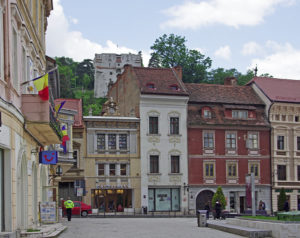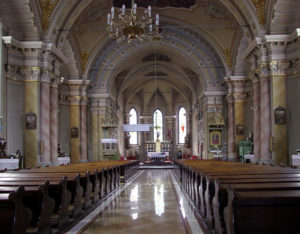Brasov is surrounded by the Carpathian mountains and the wooded hills come down to the edge of the city. High above is a big Hollywood style sign announcing BRASOV and this is one of the most cities most visited by tourists and it is always busy.
This is one of the seven Saxon cities of Transylvania and was settled by Saxons from the C12th. They built a fortified citadel on top of a hill to the north of the town to guard the Bran Pass. It was partly destroyed by fire in the C18th and damaged by earthquake in the early C19th. It was last used in the mid C19th. It was restored in the mid C20th when it was used as a political prison in Communist times.
Brasov was on the trade route between the Ottoman Empire and Western Europe. The old city was surrounded by a wall. A stretch of the wall with towers survives to the south east. There are two isolated towers, the white and black tower to the north west, which can be seen above the buildings around Piata Sfatului.
The native Romanians were not allowed to settle in the Saxon city and had their own settlement
http://wasleys.org.uk/eleanor/otherholidays/romania/day_eight/eight_four/index.html
outside the walls to the south east.
Piata Sfatului is at the heart of the old town. This is said to be the place where the Pied Piper lead the children of Hamlin. It is lined with merchant houses, many of which are now cafes. In the centre is the 1420 Old Town Hall topped by the Trumpeter’s Tower. Set back from the square behind the merchant’s houses is the C19th “ORTHODOX CATHEDRAL”:http://wasleys.org.uk/eleanor/otherholidays/romania/day_eight/eight_three/index.html (4*). This is particularly attractive on a sunny day when the light streaming through the yellow stained glass really does make the church and the iconostasis glow golden.
The surrounding streets are pedestrianised and are lined with a mix of small typically Saxon buildings with ventilation ‘eye’ in the roof and later buildings.
Strada Muresenilor is the main road taking traffic through the old town. It is lined with shops and large buildings. To the north is St Peter and St Paul Roman Catholic Church. This is locked although it is possible to look through the door.
The BLACK CHURCH (4*) at the south end, dominates the old town.This is a huge building and the largest in Romania. It was built between 1385-1477 on the site of an earlier church which was destroyed by the Mongols in 1242. The church was original Roman Catholic but became Lutheran after the Reformation. Only the reredos and a small fresco above the south east door survive from the Catholic church.
The name comes from the smoke blackened walls, a result of the church being burnt by the Austrians in 1689. Restoration work was slow as there were frequent earthquakes and took almost one hundred years. The interior is mainly Baroque in a Gothic church.
Inside, tall slender pillars accentuate the height of the church. It has one of the best collection of Anatolian rugs (Turkish prayer mats) in Romania, dating from C16th & C18th, which hang from the galleries and walls of the nave. These were given to the church by the town guilds and rich merchants. The church is regularly used for organ recitals and the pews are unusual as they have reversible backs. It does get very busy with coach tours and visitors. There is an admission charge and the church is shut on Mondays.
Near the Black Church and again set back from the road is the C19th “HOLY TRINITY CHURCH”:http://wasleys.org.uk/eleanor/otherholidays/romania/day_eight/eight_two/index.html (4*) covered with C19th frescoes. At the far side of the church is the graveyard which is a lovely place to sit and listen to the birds singing.
The area to the north of the Old Town was developed pre First World War with some large and splendid Art Nouveau buildings. These include the Prefecture, Post Office, Art Museum and the Town Hall.
Near them is Parcul Nicolae Titulescu (Central Park) which is an attractive area of grass, shrubs, trees and flowers. Old men meet here to play chess and there is a children’s adventure playground.
High rise buildings are appearing round the edge of the city.
“Brasov”:http://wasleys.org.uk/eleanor/otherholidays/romania/day_eight/eight_one/index.html is on nearly every tourist itinerary and does get very busy. Much of the old town is pedestrianised and is interesting to explore.
We spent two nights here during an eight day trip to Romania. My full report with all the pictures is “here.”:http://wasleys.org.uk/eleanor/otherholidays/romania/index.html















